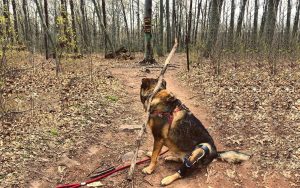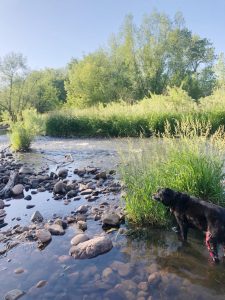What You Should Be Seeing And Tips Going Forward

Remember, this is a serious injury and most dogs need to wear their brace for nine months.
Initial Use
First, let us review how I hope you have been using the brace. Most of you are probably “morning to night” users and wearing the brace for 8-14 hours a day. Walks should have been kept to two to three per day, generally around 10 or 15 minutes at a time, as tolerated. The brace should never be worn at night or while your dog is crated.
At minimum, you should be using the brace for potty breaks, walks and while he/she is more active. If you are struggling to keep your dog’s brace on during this time, please reach out so we can help! We want you to prevent running, ball playing and zoomies as much as possible for the first three months.
Weight-Bearing On Injured Leg
At the three-month point, you should see a clear improvement in your dog’s ability to put weight on the injured leg. Your dog should be limping much less while wearing the brace, even after your walks.
It is still normal for your dog to unload the limb when they stop, or there may still be the occasional “funny walk” during faster or longer walks.
Some dogs look nearly perfect at this point and others may be only showing small improvement. By this milestone, you should see less limping and be confident the brace is helping your dog.
Time To Check-In
The three-month mark is a good time to check in with us and/or your local vet.
Your veterinarian will be able to provide essential insight as to how your dog is progressing with their ACL/CCL injury with the help of their brace.
On our end, please email, Facebook Message, or LiveChat us videos and photos of the brace on your dog for us to review. We will check to make sure everything is fitting perfectly and they are improving as expected.
The straps on the brace are most likely still in good shape, but keep an eye on them. If the elastic becomes too stretched or the Velcro is no longer sticky, it may be time for replacements. We keep all your strap measurements on file so they can quickly be mailed to you. You can change most straps at home with a screwdriver. There is a charge per strap after the 90-day warranty period.
Activity Level 3+ Months
If you’ve seen improvement in your dog’s weight-bearing, you can slowly start increasing their activity level. Gradually increase the length or difficulty of their walks. You can carefully start unleashed walks and play. You should be able to build up to running and playing while wearing the brace. This may take another three months.

If you’ve increased their activity level and your dog starts limping more than normal, you’ve pushed it a little too far. Scale the activity level back and give them more time.
Keep Wearing The Brace
Is your dog completely weight bearing on their injured leg? Do you no longer see a limp even after more strenuous activity? Some dogs look to be completely healed at this point. Keep wearing the brace! Your dog still needs support. If you take the brace off too early in the process, it is highly likely they will re-injure themselves. The scar tissue is still very fragile and can easily be damaged during strenuous activity or sudden movements.
Hopefully, this post helps to give guidance on where to go from here or encouragement in knowing you are doing everything right. Again, please reach out to us if you have any questions or concerns.
